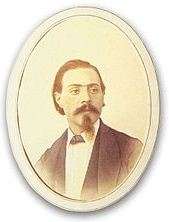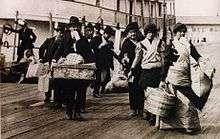Italian Colombian
Italian Colombians (Italian: Italo-colombiano, Spanish: Italo-colombiano) are Colombian citizens of Italian descent. The word may also refer to someone who has emigrated to Colombia from Italy.[2] The term "Italian" may refer to ethnic Italians. Most Italian Colombians live in Bogotá, Atlantico Department, Magdalena Department, Antioquia Department and Santander Department. Italians have been immigrating to Colombia since at least 15th century.
| |
|---|---|
| Total population | |
| 14,216 Italian citizens[1] | |
| Regions with significant populations | |
| Bogotá, Atlantico Department, Antioquia Department, Norte de Santander Department, Valle del Cauca Department | |
| Languages | |
| Colombian Spanish · Italian and Italian dialects | |
| Religion | |
| Roman Catholicism · Protestantism (Lutheranism · Evangelicalism) · Judaism |

History
During Gran Colombia and Republic of Granada
....The Italian influence in Colombia was important in science, culture, arts and laws. Furthermore, they created symbols like the country map, the National Himn and the Capitol.(La influencia italiana fue determinante en la ciencia, la cultura, las artes y el derecho de Colombia. Además, les dieron vida a símbolos como el mapa, el Himno Nacional y el Capitolio.)
— Armando Silva[3]
Very few Italians arrived in Colombia before the war of independence led by Simón Bolívar, although several hundred monks came from Italy primarily as priests and missionaries were present in the country and have left their mark in many lines of colonial society. Although few, these early Italians were present in almost all higher levels of Colombian society: in 1812 Juan Dionisio Gamba, the son of a merchant from Genoa was president of Colombia.
In the mid-nineteenth century, many Italians arrived from South Italy (especially from the province of Salerno, and the areas of Basilicata and Calabria), arrived on the north coast of Colombia: Barranquilla was the first center affected by this mass migration.
One of the first complete maps of Colombia, adopted today with some modifications, was prepared earlier by another Italian, Agustín Codazzi, who arrived in Bogota in 1849. The Colonel Agustin Codazzi also proposed the establishment of an agricultural colony of Italians, on model of what was done with the Colonia Tovar in Venezuela, but some factors prevented it.

In 1885 diplomatic relations for some years between Italy and Colombia were interrupted. When a wealthy businessman in the Italian-Colombian Cauca named Ernesto Cerruti- was placed against the oligarchy and the church favoring a liberal party and local mason, Bogota authorities confiscated their property and imprisoned. This has caused a blockade of the port by the Colombian Navy and Italian emigration in Italy was partially closed until 1899.
In November 1887 to commemorate the independence of Cartagena, has been interpreted in Bogota Variety Theatre, a fervent song with lyrics (by Rafael Núñez) which was subsequently adopted by the Law 1920 as Hymn of the Republic of Colombia: his charm and melody came from someone who had arrived as first tenor in an opera company, the Italian musician Oreste Sindici (May 31, 1828 – January 12, 1904), and who lived the last years of his life in Bogotá well acclaimed by the Colombians.
Oreste Sindici was an Italian-born Colombian musician and composer, who composed the music for the Colombian national anthem in 1887. Oreste Sindici died in Bogotá on January 12, 1904 due to severe arteriosclerosis. In 1937 the Colombian government honored his memory.[4]
Some important buildings were created by Italians in the XIX century, like the famous Colón Theater of the capital. It is one of the most representative theatres of Colombia, with a neoclassic architecture: was built by the Italian architect Pietro Cantini and founded in 1892; has more than 2,400 square metres (26,000 sq ft) for 900 people. This famous Italian architect also contributed to the construction of the Capitolio Nacional of the capital.
The sculptor Cesare Sighinolfi travelled to Bogotà, Colombia in 1880, invited by his mentor Pietro Cantini to help decorate the Teatro Cristobal Colon. He made monuments to Christopher Columbus and Isabelle the Catholic (1906). In Bogota, Cesare Sighinolfi succeeded Alberto Urdaneta, as director of the "School of Fine Arts of Bogotà": teaching alongside Luigi Ramelli and Pietro Cantini. In 1896, in Bogota he completed a portrait of Rafael Reyes.
In 1908 -according to the relation of the diplomat Agnoli to the Italian Commissary for Emigration- in Colombia there were nearly one thousand Italians: 400 in Barranquilla, 120 in Bogota, less than 100 in Cartagena and Bucaramanga, while only a few dozens lived in Cucuta and other minor cities. Most of the Italians were from Veneto and Tuscany; their main activity was in commerce and restaurants/hotels but 30 Italians owned huge lands and successfully cultivated with farms.[5]
World War II
After the Second World War, Italian emigration to Colombia was directed primarily toward Bogota, Cali and Medellin. Italian immigrants in Colombia are mainly concentrated in the capital region (and secondarily in Cali & Medellin). They have Italian schools in Bogota (Institutes "Leonardo da Vinci" and "Alessandro Volta"), Medellín ("Leonardo da Vinci]]") & Barranquilla ("Galileo Galilei").
Furthermore there are some institutions promoted by the Italian government, like the "Sociedad Dante Alighieri", the "Instituto de Cultura italiana" and the "Casa de Italia" in the capital.[6]
Italian Immigration to Colombia
Approximately 30,000 Italians have emigrated to Colombia since colonial times. It is calculated, by the Italian Embassy in Bogota, that in 2010 more than 2 million Colombians have distant roots in Italian emigrants: like the famous Shakira, who has an half-Italian mother.[7]
Actually 14,216 Italians are residents in Colombia (2011 "Anagrafe Italiani iscritti estero - AIRE")


Italian Immigration by Region
| Region | Percentage |
|---|---|
| Veneto | 26.6% |
| Campania | 12.1% |
| Calabria | 8.2% |
| Lombardy | 7.7% |
| Tuscany | 5.9% |
| Friuli-Venezia Giulia | 5.8% |
| Trentino-Alto Adige/Südtirol | 5.3% |
| Emilia-Romagna | 4.3% |
| Basilicata | 3.8% |
| Sicily | 3.2% |
| Piedmont | 2.8% |
| Apulia | 2.5% |
| Marche | 1.8% |
| Molise | 1.8% |
| Lazio | 1.1% |
| Umbria | 0.8% |
| Liguria | 0.7% |
| Sardinia | 0.4% |
| Aosta Valley | 0.2% |
Language
Italian immigrants have integrated easily into Colombian society. Today the vast majority of their descendants only speak Spanish, the national language of Colombia. Approximately 4.3% of the natives still speak (or understand a little) the Italian in 2008. In the last century here has been an influence of the Italian language in some Colombian words [8].
Cuisine
Italians brought new recipes and types of food to Colombia but also helped in the development of Colombian's cuisine. Spaghetti and pizza are some of the favorite foods in actual Colombia thanks to them.
See also
References
- Departamento del Interior y Ordenación del Territorio de Italia. "Annuario Statistico 2009" (PDF). pp. 121–129. Retrieved November 24, 2009.
- A game of mirrors: the changing face of ethno-racial constructs and language in the Americas. Thomas M. Stephens. University Press of America, 2003. ISBN 0-7618-2638-6, ISBN 978-0-7618-2638-5. Retrieved on 2010-10-14.
- Armando Silva. "Cultura italiana en Colombia: reflexión sobre etnias y mestizajes culturales".Introduccion
- "Símbolos patrios de Colombia" (in Spanish). Presidencia de Colombia. Archived from the original on March 9, 2012. Retrieved November 1, 2010.
- Colombia - p.363
- "Instituciones y Escuelas italianas en Colombia (in Italian)" (PDF). Archived from the original (PDF) on 2012-03-09. Retrieved 2019-04-03.
- One of the grandmothers of Shakira has the Italian surname "Torrado" and was born in Italy
- Italian words in the Spanish Colombian language